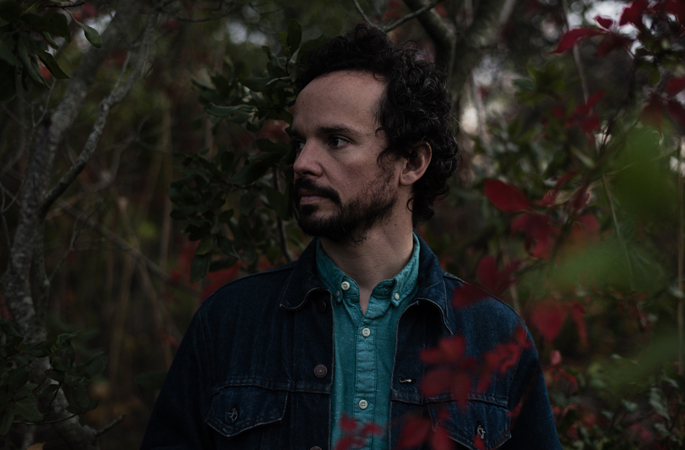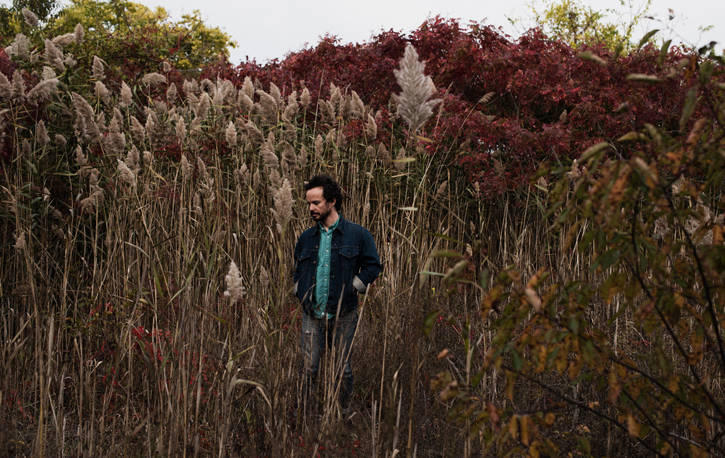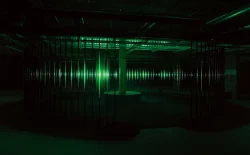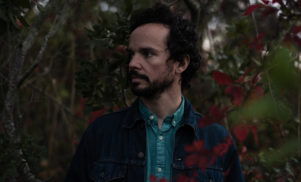Jefre Cantu-Ledesma is showing me his ceramics.
As we reach the end of our conversation over Skype, he dips out of sight of the camera and returns with a pair of vases. My grainy camera viewpoint doesn’t do them justice, but even so there’s nothing grand or showy about these pretty little pots, one a soft blue-grey and the other a deep blue marked with turquoise.
“When I moved to New York,” he explains from his home there, “I wanted to experience something where I was forced to be innocent purely because I didn’t know what I was doing.” He’s certainly been making music a good deal longer than ceramics, having been in bands such as Tarantel and The Alps since the mid-’90s and releasing several albums, tapes, DVD-Rs, and CD-Rs as a solo musician, as well as running the experimental Root Strata label, and collaborating with artists such as Liz Harris. But Cantu-Ledesma applies a similar creative approach to both pottery and music. Innocence, he explains, is central to his method of “just playing and seeing where it goes. I record that whole process and at some point I’ll get to the end and find where the songs are.”
Having whittled down hours of recordings, Cantu-Ledesma will sequence and title them into an LP. Some four years have passed between Love Is A Stream, his most recent album on Type, and A Year With 13 Moons, for Mexican Summer. But a steady stream of low-key releases such as the 2014 cassettes Songs of Forgiveness and Songs of Remembrance gives some insight into Cantu-Ledesma’s process. Remembrance shares with A Year With 13 Moons a palette of beats, shoegaze guitars and poppy motifs, a far cry from the ambient drones Cantu-Ledesma is best known for. Yet while the first is a collection of refined sketches of sorts, A Year With 13 Moons possesses a very real sense of narrative momentum.
“When I got to the end, I was like, ‘wow, this is a breakup record.'”
The latest album is named for a film (Rainer Werner Fassbinder’s In einem Jahr mit 13 Monden) but is about Cantu-Ledesma’s experience of where his life was at the time of watching it rather than the film itself. That seems especially apt given the musician’s long collaborative relationship with the filmmaker and visual artist Paul Clipson, whom he worked with on A Year With 13 Moons at an artists’ residency in the spring of 2013. And just as the sped-up vignettes in Clipson’s videos, such as the one for ‘Love After Love’, seem to organise themselves into stories, so A Year With 13 Moons threads together disparate motifs and sounds – from ’80s indie-pop to drone – to similar effect. It is also one of Cantu-Ledesma’s most poignant albums to date; a reflection of a difficult personal period he was going through at the time of recording, something which the song titles bear out. ‘The Last Time I Saw Your Face’, ‘Pale Flower’ and ‘Mirror Of Past & Future’ describe lost or faded love, while ‘Görlitzer Park’ and ‘Agate Beach’ are like snapshots, framing specific places and times whose true significance is known only to the artist himself.
I understand that A Year With 13 Moons was recorded at an artists’ residency with Paul Clipson. Could you tell me a bit about it?
It was in a place called the Headlands Center for the Arts in the San Francisco Bay, right across from the Golden Gate Bridge. It’s an old army base that got turned into an artists’ residency programme in the ’80s. Paul and I applied while I was living in Germany, and when I moved back to the States, I had the opportunity to live full-time up there and be in the studio every day. He would come up a few days a week. We don’t spend too much time discussing how to make a piece, we just talk about art, or film, or music. I would make a lot of music on my own and he would listen to a lot of it. We shared an apartment together so when he stayed we’d spend a lot of time listening to what I was working on, and he just shot film. I think we did three performances while we were there that documented the process, and by the end of it, I had already been asked to make a record. I was working on that record while I was there, and it ended up being A Year With 13 Moons.
How did that working relationship come about?
Paul and I met when we worked together in a museum in San Francisco for many years. Before we started working together, we developed a friendship around film. He’s really deeply into it and turned me on to so much stuff, and I started turning him on to music, and we just developed a rapport that way. At the time I was in Tarantel, and had been for many years. Paul ended up touring with Tarantel, and just kind of being part of the band and showing films at all of our shows. He and I have a very tight personal relationship, so it was easy for us to make it work together. I like him because when we perform together, it almost takes the pressure off. It allows for this third thing to happen which isn’t just film or just music; it’s some kind of combination of the two, and as a musician that allows me to do less without feeling like it’s losing momentum.
When we watch films, when we look at visuals, there isn’t necessarily an expectation that music has to be a certain way, and that’s really freeing in terms of how spontaneous the music can be. I can let loose and not worry about if it makes sense as a composition, because it’ll somehow make sense with visuals. When I’ve seen Paul play with Liz [Harris aka Grouper] and other people, my experience is that you’re automatically going to make a narrative. It doesn’t matter how minimal or maximal the music is – your brain automatically makes a story. As a musician, that’s really nice because you can just do almost nothing sometimes.
What kind of visuals was Paul working on at the time?
He shoots primarily in Super-8 film. Super-8 is malleable, and you can do a lot of layering and psychedelic things with it. You can go off the deep end with it.
That layered, psychedelic aspect relates quite strongly to A Year With 13 Moons, but you say the two of you work separately.
My process with making music was pretty insular. I would play Paul music as I was making it and he was very supportive, but we didn’t talk about how it would work with performing it together or anything like that. We come together for shows but I don’t even see the films! My back is to them, and Paul’s already edited before he’s even heard anything. My sets are highly improvised, too. The two things just kind of come together and viewers put narrative there because we’re just moving through time.
There’s obviously also a narrative mapped onto the album, one that’s focused strongly on the passage and loss of time. How did you go about writing or editing it that way?
I didn’t write in the sense that one sits down and composes. The record was culled from hours and hours and hours of music. I was at the Headlands for three months, in my studio six hours a day, seven days a week. So by the time I got to putting the record together, I had so much music. It’s funny – Paul and I talked on the phone the other day, and he was asking about it because he’d started listening to the record again. He said it sounds like I edited it like a film, and I think that’s right. I look for scenes and put them together. I allow the music to guide me in a way that creates its own narrative.
The other side of it is that I moved back to America after living in Germany for a year and a half, and I was going through a separation that led to a divorce, and a lot of it was just dealing with that shit. The record ended up being about my time away in another country, which was really disruptive. I lived in San Francisco for nearly 20 years before I moved to Germany, and when I was in Germany for a year and a half I didn’t really have time to make music, not intensely. It was very disorienting. So I was back in the Bay, alone and going through this separation, and all this stuff just kind of came up. I was reflecting on it in a way that really wasn’t obvious to me at the time, but when I got to the end, I was like, ‘wow, this is a breakup record.’
Do you ordinarily work this way – recording intuitively, and then feeling out the mood later in the process?
Not always. In collaboration with people, that’s not how it is. For instance, when Liz and I work together, that tends to be a little more composed or worked out. When I was in The Alps, we would work on parts and changes, and that kind of stuff. As a solo musician, I find I gravitate more towards creating situations in which I can just play, setting up my equipment in a certain way, or using a particular piece of gear, and then just playing and seeing where it goes. I record that whole process and at some point I’ll get to the end and find where the songs are. I’ve always been interested in the idea of music as a diary or a catalogue of what’s happening in your life. When you put the ideas together, a narrative relationship is created.
I studied painting at school, and as I’ve got older as a musician and developed a craft and become more comfortable with what I do, I can see similarities between my painting process and the music. You make a bunch of work as a painter or photographer but you don’t show every piece. It’s like when we watch films, we might be seeing only 10 per cent of what was shot. At the time, you never know how you’re going to later reflect on something. But when you distance yourself from your work it becomes independent. Then I can look at the pieces as if they’re photographs, and arrange them in a way that’s interesting. Songs of Remembrance is that idea for me as well.
I wanted to talk about Songs of Remembrance. There’s this nostalgic ’80s indie-pop influence on both that tape and A Year With 13 Moons. Why did you want to start incorporating that kind of style into your music?
I’m not a huge planner. Honestly, I can’t tell you how it happened, and I think it was just a really slow process of getting frustrated with making ambient drone music and just needing to mix things up. I played in Tarantel and those bands for years, and I think in retrospect I was just trying to be in a band again!
It started with drums, just getting a little bit curious to see what it would sound like if I used a drum machine. Before I knew it, I was in a whole other world wondering, how did I get here? I think from the outside the gaps of years between records make the transitions seem more different, but it’s really a gradual process. It’s not like I woke up one day and thought, wow, I really want to work out my Durutti Column obsession! I just slowly started thinking I should do stuff with cleaner guitars, use a drum machine.
“Maybe I’ll make some pop songs, and then I’ll make a noise record, and then I’ll make a record with just piano.”
Well, you have the cassettes and Headlands Center releases acting as a kind of diary in that sense.
That’s true. They’re great opportunities to explore new territory without a lot of pressure, and to try new ideas. Richard Youngs has done a record for Root Strata. I remember asking him to do a record and he wrote me back saying he’d love to do it but he had no idea what it was going to be like. I love that! You know it’ll be great because it’s Richard Youngs, and I aspire to being open enough to that, like maybe I’ll make some pop songs, and then I’ll make a noise record, and then I’ll make a record with just piano.
Why were you getting frustrated with making ambient drone?
I think the first time I did anything that was more pop-leaning was a 7″ called ‘Faceless Kiss’. That was partly a format thing. The friends who run that label [Emerald Cocoon] asked me to do a 7″, and I thought I’d try something totally different. At that time I felt challenged in a way I didn’t when I was doing drone pieces, and it let me tap into a different part of myself.
So how did you get away from that kind of sound for A Year With 13 Moons?
I had a guitar, modular, a number of tape machines – reel-to-reel but also small cassette tapes – and was creating drumbeats digitally with samples of LinnDrum and Rhythm Ace drum, and that was pretty much it. I wanted to see how much I could change, expand and shift without much deviation. I did have some anxiety about it because I thought I should be an experimental musician, and there was something too straightforward about it to start with. But I owe a lot to Pete Swanson, because he really encouraged me.
I was wondering if Pete was involved at any point. Obviously the two of you are close [Cantu-Ledesma dedicated ‘Distant Star’ from Shining Skull Breath to Swanson]. What kind of input did he have?
He was saying, ‘you should be writing pop songs’! I’ll often send stuff to musician friends and Pete was really encouraging, telling me to go down that pop road. I owe him a lot of gratitude. I was worried I wasn’t being avant-garde enough or something, but I got over it. I can’t speak for him of course, but Pete grew up going to raves, so for him to incorporate beats into his work felt natural. It’s the same for me with pop, listening to Slowdive and Cocteau Twins when I was in college but never really thinking that it was something I would investigate musically, and then coming full circle. And it felt really good, and it reminded me of that time in my life. Okay, I turned 40 last year and there are a lot of people making music about nostalgia and stuff, but it’s not about nostalgia for me. When I play guitar, it doesn’t feel like a nostalgic thing, or like trying to reference or comment on a specific time. It feels more intuitive than that.
The resulting music has a nostalgic atmosphere, though.
Even listening to early Tarantel recordings, the first of which were around 1995 or 1996, I’ve always been drawn to things that are a bit more melancholic, autumnal. That’s been a thread through the whole time I’ve been making music, anyway.
Let’s talk a bit about the titles. I like ‘A Portrait of You at Nico’s Grave, Grunewald’ because it’s so evocative. Why did you dedicate it to Bill Kouligas?
Those titles in particular were very much about living in Berlin and going through a very difficult breakup. I saw this picture on Bill’s Facebook, or at his house or something, of him at Nico’s grave. It is a direct reference to a person and a time. The titles are so obviously personal because I’m trying to inject a bit of that into my music, and the music refers to specific people and places and times in my life. Songs are named after rivers in Germany and a park in Berlin. The name of the record is a film. It’s not about the film, though – it’s about my experience of where my life was at the time I watched the film.
I like the gulf between these very real, specific experiences and the way the record can be really psychedelic at times.
It’s like trying to make sense of it. In a way, the music comes out of nothing, and who knows where it comes from. Where does creativity come from? But you open up and make things, and in retrospect it becomes a map for a particular time and place. Sometimes I look at older stuff and think, wow, was I really in that place? But you can’t let that cripple the innocence that’s really required to make work now.
What innocence is that?
Innocence implies no expectations. When we engage in life with no expectations, or acknowledge that we have them and try to move forward, there’s an opportunity there. Creativity is a bit of a mystery, and I want to have respect for that. For me, that means having some innocence. Take these ceramics; I studied painting, and got sidetracked by Tarantel, and didn’t do much visual art except record covers for Root Strata and other friends. When I moved to New York and my life had gotten so uprooted – and New York is so fucking insane – I wanted to experience something where I was forced to be innocent purely because I didn’t know what I was doing, and that’s totally okay. I’ve been making ceramics for about a year now, and I like allowing the work to create itself. It’s not always about how something is being created, and more about the attitude towards it.
Photos by Shawn Brackbill.































